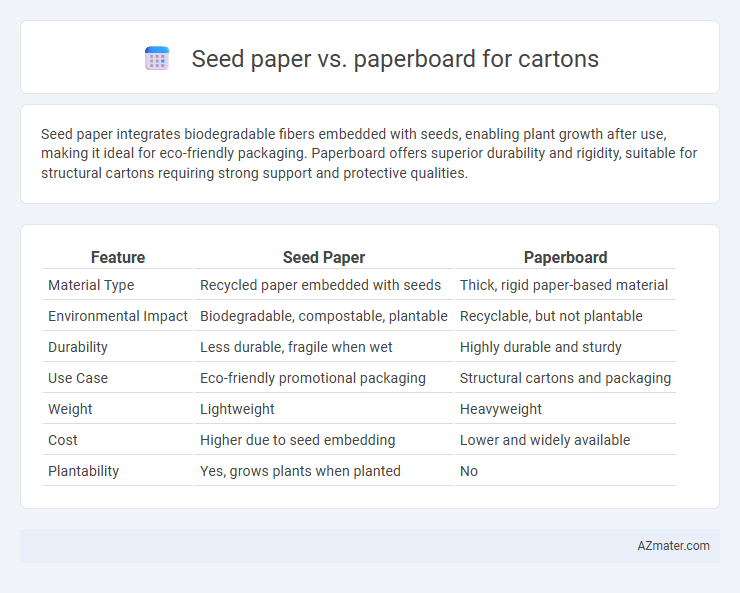Seed paper integrates biodegradable fibers embedded with seeds, enabling plant growth after use, making it ideal for eco-friendly packaging. Paperboard offers superior durability and rigidity, suitable for structural cartons requiring strong support and protective qualities.
Table of Comparison
| Feature | Seed Paper | Paperboard |
|---|---|---|
| Material Type | Recycled paper embedded with seeds | Thick, rigid paper-based material |
| Environmental Impact | Biodegradable, compostable, plantable | Recyclable, but not plantable |
| Durability | Less durable, fragile when wet | Highly durable and sturdy |
| Use Case | Eco-friendly promotional packaging | Structural cartons and packaging |
| Weight | Lightweight | Heavyweight |
| Cost | Higher due to seed embedding | Lower and widely available |
| Plantability | Yes, grows plants when planted | No |
Introduction: Seed Paper vs Paperboard for Cartons
Seed paper integrates biodegradable fibers embedded with seeds that sprout when planted, offering an eco-friendly alternative for carton packaging. Paperboard, a thicker and more rigid material, provides structural strength and durability essential for protecting products during shipping and storage. Choosing between seed paper and paperboard depends on the balance between sustainability goals and functional packaging requirements.
Understanding Seed Paper: Composition and Benefits
Seed paper is composed of biodegradable materials embedded with seeds that sprout when planted, making it an eco-friendly alternative to traditional paperboard for cartons. Its unique composition combines recycled fibers with natural seeds, promoting sustainability by reducing waste and encouraging plant growth. Benefits of seed paper include enhanced brand image through eco-conscious packaging, reduced environmental impact, and the added value of a product that customers can actively engage with post-use.
What is Paperboard? Characteristics and Uses
Paperboard is a thick, durable paper-based material commonly used for packaging cartons due to its rigidity and ability to protect contents. Its characteristics include high stiffness, excellent printability, and recyclability, making it suitable for product packaging, shipping boxes, and food containers. Paperboard's strength and versatility allow it to be easily cut and folded into various carton shapes, enhancing its use in retail packaging and display applications.
Environmental Impact: Seed Paper vs Paperboard
Seed paper decomposes naturally within weeks, enriching soil by releasing embedded seeds and reducing landfill waste, making it highly eco-friendly. Paperboard, while recyclable and biodegradable, requires significant energy and resources during production, contributing to higher carbon emissions. Choosing seed paper over paperboard decreases environmental impact by promoting sustainability and minimizing resource consumption.
Biodegradability and Sustainability Comparison
Seed paper, embedded with plant seeds, offers superior biodegradability as it decomposes naturally while promoting plant growth, enhancing sustainability through a closed-loop lifecycle. Paperboard, typically thicker and more durable, varies in biodegradability depending on coatings and additives but generally supports recycling processes, contributing to resource conservation. Both materials advance eco-friendly packaging solutions, yet seed paper uniquely combines biodegradability with active environmental regeneration, whereas paperboard excels in structural strength and recyclability.
Printing and Customization Capabilities
Seed paper offers unique printing opportunities with its textured, fibrous surface that enhances eco-friendly branding while supporting bespoke designs through natural embossing and tactile effects. Paperboard excels in high-quality, sharp printing due to its smooth, consistent finish, providing vibrant colors and detailed graphics ideal for intricate customization. Both materials allow flexible design options, but paperboard delivers superior print clarity, whereas seed paper emphasizes sustainability alongside innovative customization.
Cost Analysis: Seed Paper Versus Paperboard Packaging
Seed paper packaging typically incurs higher initial costs compared to conventional paperboard due to specialized materials and production processes. Paperboard offers a more cost-effective solution for large-scale carton manufacturing, benefiting from established supply chains and lower raw material expenses. However, seed paper's added value as an eco-friendly option may justify the premium in sustainable packaging markets.
Durability and Protection: Which Performs Better?
Seed paper typically offers lower durability and protection compared to paperboard, as it is designed to be biodegradable and break down in soil. Paperboard excels in structural strength and impact resistance, making it the preferred choice for cartons requiring high durability and product protection during shipping and handling. For packaging solutions where product safety and longevity are critical, paperboard provides superior performance.
Consumer Appeal and Brand Perception
Seed paper offers a unique, eco-friendly appeal that enhances consumer engagement by allowing customers to plant the packaging, aligning brands with sustainability values and promoting positive environmental impact. Paperboard for cartons provides a sturdy, traditional packaging solution that conveys reliability and quality but may lack the innovative or green branding appeal of seed paper. Brands utilizing seed paper can differentiate themselves in the market by showcasing commitment to sustainability, which often leads to stronger consumer loyalty and a more favorable brand perception.
Choosing the Right Material for Your Carton Needs
Seed paper offers eco-friendly benefits with its biodegradable and plantable qualities, making it ideal for sustainable packaging and promotional cartons. Paperboard excels in durability and structural integrity, providing excellent protection and printability for heavy or detailed carton designs. Selecting the right material depends on prioritizing environmental impact with seed paper or strength and versatility with paperboard for your specific carton requirements.

Infographic: Seed paper vs Paperboard for Carton
 azmater.com
azmater.com